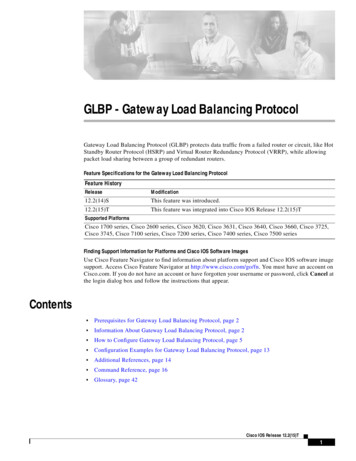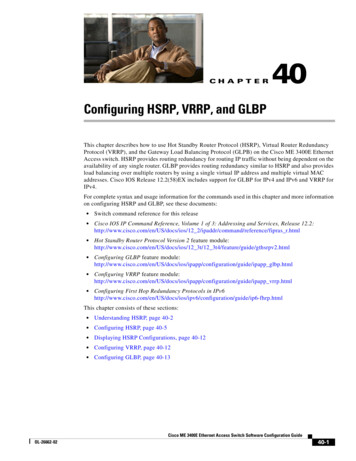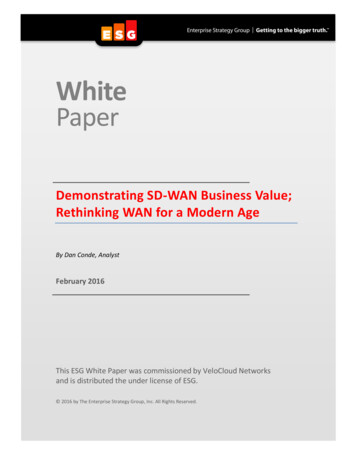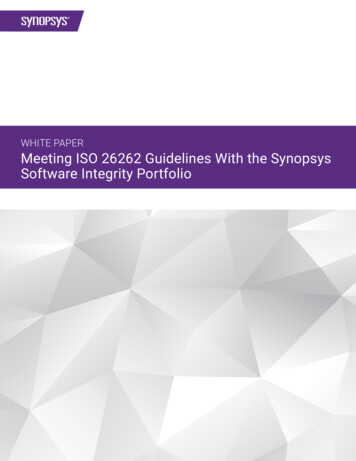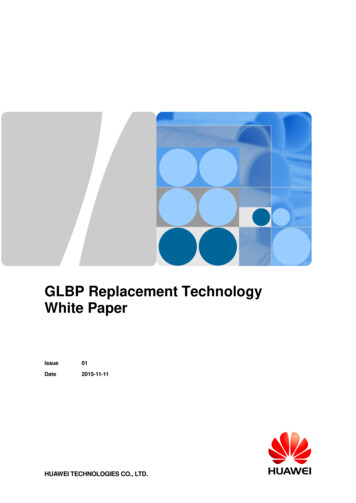
Transcription
GLBP Replacement TechnologyWhite PaperIssue01Date2015-11-11HUAWEI TECHNOLOGIES CO., LTD.
GLBP Replacement Technology White PaperAbout This DocumentCopyright Huawei Technologies Co., Ltd. 2015. All rights reserved.No part of this document may be reproduced or transmitted in any form or by any means without priorwritten consent of Huawei Technologies Co., Ltd.Trademarks and Permissionsand other Huawei trademarks are trademarks of Huawei Technologies Co., Ltd.All other trademarks and trade names mentioned in this document are the property of their respectiveholders.NoticeThe purchased products, services and features are stipulated by the contract made between Huawei andthe customer. All or part of the products, services and features described in this document may not bewithin the purchase scope or the usage scope. Unless otherwise specified in the contract, all statements,information, and recommendations in this document are provided "AS IS" without warranties, guarantees orrepresentations of any kind, either express or implied.The information in this document is subject to change without notice. Every effort has been made in thepreparation of this document to ensure accuracy of the contents, but all statements, information, andrecommendations in this document do not constitute a warranty of any kind, express or implied.Huawei Technologies Co., Ltd.Address:Huawei Industrial BaseBantian, LonggangShenzhen 518129People's Republic of ChinaWebsite:http://e.huawei.comIssue 01 (2015-11-11)Huawei Proprietary and ConfidentialCopyright Huawei Technologies Co., Ltd.i
GLBP Replacement Technology White PaperAbout This DocumentAbout This DocumentThis document compares Cisco Gateway Load Balancing Protocol (GLBP) with the VirtualRouter Redundancy Protocol (VRRP) and provides GLBP configuration procedures in hybridnetworking scenarios.Intended AudienceThis document is intended for: Network planning engineers Commissioning engineers Data configuration engineers Onsite maintenance engineers Network monitoring engineers System maintenance engineersSymbol ConventionsThe symbols that may be found in this document are defined as follows.SymbolDescriptionIndicates a hazard with a high level or medium level of riskwhich, if not avoided, could result in death or serious injury.Indicates a hazard with a low level of risk which, if notavoided, could result in minor or moderate injury.Indicates a potentially hazardous situation that, if not avoided,could result in equipment damage, data loss, performancedeterioration, or unanticipated results.Provides a tip that may help you solve a problem or save time.Provides additional information to emphasize or supplementimportant points in the main text.Issue 01 (2015-11-11)Huawei Proprietary and ConfidentialCopyright Huawei Technologies Co., Ltd.ii
GLBP Replacement Technology White PaperAbout This DocumentChange HistoryChanges between document issues are cumulative. The latest document issue contains all thechanges made in earlier issues.Issue 01 (2003-05-20)This issue is the first official release.Issue 01 (2015-11-11)Huawei Proprietary and ConfidentialCopyright Huawei Technologies Co., Ltd.iii
GLBP Replacement Technology White PaperContentsContentsAbout This Document . ii1 Overview . 11.1 Cisco GLBP . 11.2 Working Principle. 11.2.1 State Machines . 21.3 VRRP. 31.3.1 Working Principle . 31.3.2 State Machines . 31.4 LBRG . 41.4.1 Working Principle . 41.4.2 State Machines . 52 Replaceability Analysis . 72.1 Replacement Solution . 72.2 Configuration Command Comparison . 73 Hybrid Networking Example . 93.1 Example 1: Basic Network Configuration . 93.1.1 Network Topology . 93.1.2 Network Configuration .104 References . 11Issue 01 (2015-11-11)Huawei Proprietary and ConfidentialCopyright Huawei Technologies Co., Ltd.iv
GLBP Replacement Technology White Paper1 Overview1Overview1.1 Cisco GLBPThe Gateway Load Balancing Protocol (GLBP) provides extended functions based on theVRRP protocol. In a Virtual Router Redundancy Protocol (VRRP) group, a master routermust be elected, and the backup router is in idle state. However, GLBP provides not onlyredundant gateways but also load balancing among gateways.GLBP allows one virtual IP address to be mapped to up to four virtual MAC addresses toachieve load balancing. Members in a GLBP group have the same virtual IP address andcommunicate with each other through hello messages. The multicast IP address of these hellomessages is 224.0.0.102, and the messages are carried in User Datagram Protocol (UDP)packets.1.2 Working PrincipleMembers of a GLBP group elect one gateway as an active virtual gateway (AVG) for thegroup. The election process is similar to the process of VRRP Master election.The selected AVG then assigns a virtual MAC address to each member of the GLBP group.Each member assumes responsibility for forwarding packets to the virtual MAC address thatis assigned to it by the AVG. Members assigned with virtual MAC addresses are called ActiveVirtual Forwarders (AVFs).The AVG is responsible for responding to Address Resolution Protocol (ARP) request packetsdestined for the virtual IP address. Load balancing is achieved by the AVG responding to theARP request packets with different virtual MAC addresses. Members of a GLBP groupcommunicate with each other through hello messages. These hello messages are sent every 3seconds and carry the assigned virtual MAC addresses.After receiving a hello message, an AVF learns the virtual MAC address carried in themessage and saves it as a redundant virtual MAC address.An AVF contains the virtual MAC addresses assigned by the AVG and learned from otherAVFs. An AVF that is assigned with the virtual MAC address by the AVG is known as aprimary virtual forwarder. A virtual forwarder that has learned the virtual MAC address iscalled as a secondary virtual forwarder.If an AVF fails, another AVF that has learned the virtual MAC address is elected to take overthe faulty AVF to forward packets. The election process is similar to the process of VRRPIssue 01 (2015-11-11)Huawei Proprietary and ConfidentialCopyright Huawei Technologies Co., Ltd.1
GLBP Replacement Technology White Paper1 OverviewMaster election. Since one virtual MAC address is unavailable but is still used by users forforwarding packets, a buffer time is required to switch to another virtual MAC address forforwarding packets. GLBP uses two timers to process packets sent from the original virtualMAC address. Before the first timer expires, the AVG can still uses the original virtual MACaddress to respond to ARP request packets. Before the second timer expires, the packets fromthe original virtual MAC address can still be forwarded.1.2.1 State MachinesGLBP defines three states.Issue 01 (2015-11-11)Huawei Proprietary and ConfidentialCopyright Huawei Technologies Co., Ltd.2
1 OverviewSt Recartup eiveme s assages a gei ve e ssaceRe wn motDuShSh RutD eceo w i venm saessageGLBP Replacement Technology White PaperReceives a packet for assigninga virtual MAC address UNKNOWN: The initial status of all members in a GLBP group is UNKNOWN. Whenattributes are configured for the group members or member interfaces are Up, themembers' states become UNKNOWN. LISTEN: When a GLBP group in UNKNOWN state receives a Startup message, thegroup changes its GLBP state to LISTEN. ACTIVE: When a GLBP group in LISTEN state receives a packet for assigning a virtualMAC address, the group changes its GLBP state to ACTIVE.1.3 VRRPVRRP is defined by RFC2338, providing the backup mechanism for devices in LANs.1.3.1 Working PrincipleVRRP provides similar functions as Cisco GLBP and has a similar working principle as CiscoGLBP.1.3.2 State MachinesVRRP defines three states.Issue 01 (2015-11-11)Huawei Proprietary and ConfidentialCopyright Huawei Technologies Co., Ltd.3
GLBP Replacement Technology White Paper1 Overviewndoshdoutethor wn .wn odo s Dut n ish i oi s ssk selin FDeTh nk BlinwUTBi hedire l i n kci(B tion s shFD alu) s For t does wa wnsi o r d on ing r thisDo De e linwn tec k. tionInitializeThe priority changes, the PeerBFD session is Down, or theprotocol timer expires.BackupMasterThe priority changes. Master: A master router forwards gateway traffic, responds to ARP request packets, andperiodically sends VRRP protocol packets destined for the multicast IP address224.0.0.18 to maintain the active/standby device status in the VRRP group. Backup: A backup router monitors heartbeat packets from the master router. If thepriority changes or the backup router does not receive any packets from the master routerwithin the Master Down Interval, the backup router becomes the master, but does notforward traffic or respond to ARP request packets destined for the virtual IP address. Initialize: When the VRRP-enabled interface is down, the device in Initialize state doesnot process VRRP packets, forward traffic, or take part in the active/standby deviceelection in the VRRP group.1.4 LBRGLoad-Balance Redundancy Group (LBRG) is a protocol extended by Huawei based on VRRP.The LBRG feature is supported by Huawei CE series switches and will be supported by laterversions of Sx700 series campus switches in the future.1.4.1 Working PrincipleLBRG uses a virtual IP address to respond to packets from different virtual MAC addresses.User traffic is directed to and load balanced among outbound interfaces based on virtual MACaddresses.Issue 01 (2015-11-11)Huawei Proprietary and ConfidentialCopyright Huawei Technologies Co., Ltd.4
GLBP Replacement Technology White Paper1 OverviewPrimary virtual IP address of VRRP1 (LBRG): 1.1.1.1Secondary virtual IP address of VRRP2: 1.1.1.2Primary virtual IP address of VRRP3: 1.1.1.3Gatway: 1.1.1.1Device 1VMAC:0000-5E00-0101VMAC:0000-5E00-0102Gatway: 1.1.1.1VMAC:0000-5E00-0103IP/MPLSCoreGatway: 1.1.1.1SwitchInternetGatway: 1.1.1.1VMAC:0000-5E00-0102Device 2VMAC:0000-5E00-0103Gatway: 1.1.1.1Primary virtual IP address of VRRP3: 1.1.1.3Secondary virtual IP address of VRRP2: 1.1.1.2Primary virtual IP address of VRRP1 (LBRG): 1.1.1.1Implementation: LBRG uses a virtual IP address to respond to packets from different virtual MAC addresses. Usertraffic is directed to and load balanced among outbound interfaces based on virtual MAC addresses.Solution: 1. Set VRRP1 as the LBRG, and add VRRP2 and VRRP3 to the LBRG.2. The active device in VRRP1 responds to ARP request packets when VRRP1 is used as the user gateway.3. VRRP1 responds to ARP request packets with a virtual MAC address that is selected from the LBRG using thehash algorithm based on the user's IP address and MAC address.4. VRRP1 cannot send gratuitous ARP packets after it is set as the LBRG.Gatway: 1.1.1.11.4.2 State MachinesLBRG defines the same three states as those defined by VRRP.klinethn.or ing wn rd D oow wa ist d or ionh u a l F sss s n sek i tio )lin ec FDe idir ( BTh B nonctiwtedoutDeUndoTheshliB nkDe idi iste rec shucti tio ton na do( B l F wnDo FD orw orwn ) se ard the.ss i n l i nion gkisInitializeThe priority changes, thePeer BFD session is Down, orthe protocol timer times out.BackupMasterThe priority changes. Master: A master router forwards gateway traffic, responds to ARP request packets, andperiodically sends VRRP protocol packets destined for the multicast IP address224.0.0.18 to maintain the active/standby device status in the VRRP group. Backup: A backup router monitors heartbeat packets from the master router. If thepriority changes or the backup router does not receive any packets from the master routerIssue 01 (2015-11-11)Huawei Proprietary and ConfidentialCopyright Huawei Technologies Co., Ltd.5
GLBP Replacement Technology White Paper1 Overviewwithin the Master Down Interval, the backup router becomes the master, but does notforward traffic or respond to ARP request packets destined for the virtual IP address. Issue 01 (2015-11-11)Initialize: When the VRRP-enabled interface is down, the device in Initialize state doesnot process VRRP packets, forward traffic, or take part in the active/standby deviceelection in the VRRP group.Huawei Proprietary and ConfidentialCopyright Huawei Technologies Co., Ltd.6
GLBP Replacement Technology White Paper2 Replaceability Analysis2Replaceability Analysis2.1 Replacement SolutionGLBP is a Cisco proprietary protocol and is not interoperable with other redundancyprotocols. VRRP provides similar functions as GLBP and has been implemented on HuaweiSx700 series campus switches. Therefore, VRRP can be used to replace Cisco GLBP and canbe smoothly upgraded to LBRG in the future.Generally, a Cisco device and a Huawei device are not deployed for gateway redundancy. TheVRRP protocol can be used to replace GLBP on the original network. This documentdescribes the solution to replace GLBP on all gateway devices on a network.2.2 Configuration Command ComparisonConfigurationCiscoHuaweiConfiguring avirtual IP addressglbp group ip [ip-address[secondary]]vrrp vrid virtual-router-id [ virtual-ip virtual-address ]vrrp vrid vrid load-balancevrrp vrid virtual-router-id joinload-balance-vrrp vrid lb-vrid-value Configuringpackettransmissionparametersglbp group timers [msec]hellotime [msec] holdtimeConfiguring apriorityglbp group priority levelvrrp vrid vrid priority priority Configuring thepreemption modeglbp group preempt [delayminimum seconds]vrrp vrid vrid preempt-mode timerdelay delay-time Configuring theauthenticationmodeglbp group-numberauthenticationvrrp vrid virtual-router-id authentication-mode { simple key md5 md5-key }Issue 01 (2015-11-11)vrrp vrid virtual-router-id timeradvertise{ adver-interval millisecond millisecond-interval }{text string md5Huawei Proprietary and ConfidentialCopyright Huawei Technologies Co., Ltd.7
GLBP Replacement Technology White PaperConfiguration2 Replaceability AnalysisCiscoHuawei{key-string [0 7] key key-chain nameof-chain}}Configuring atracking objectglbp group weighting trackobject-number [decrementvalue]vrrp vrid virtual-router-id trackinterface { interface-type interface-number interface-name } [ increased value-increased reduced value-reduced ]vrrp vrid virtual-router-id track iproute ip-address { mask mask-length } [ vpn-instance vpn-instance-name ] [ reduced value-reduced ]Configuring thepreemption modefor a forwarderglbp group forwarderpreempt [delay minimumseconds]vrrp vrid vrid preempt-mode timer delay-time delayComparison between configuration commands on Cisco and Huawei devices: GLBP configuration on Cisco device:Router(config)# interface fastethernet 0/0Router(config-if)# ip address 10.21.8.32 255.255.255.0Router(config-if)# glbp 10 timers 5 18Router(config-if)# glbp 10 timers redirect 1800 28800Router(config-if)# glbp 10 load-balancing host-dependentRouter(config-if)# glbp 10 priority 254Router(config-if)# glbp 10 preempt delay minimum 60Router(config-if)# glbp 10 client-cache maximum 1200 timeout 245 VRRP configuration:interface Vlanif1vrrp vrid 1 virtual-ip 192.168.16.254/*Set the same virtual IP address for routers in a VRRP group.vrrp vrid 1 priority 120/*Define the priority of the active router in group 1. A router with a higher value ismore likely to become the active router.vrrp vrid 1 timer advertise 3/*Set the interval for sending hello messages and holdtime of hello messages.Specify that hello messages are exchanged every 3 seconds in group 1 and the active/standby switchover is triggeredwhen a hello messages is not received within 9 seconds.vrrp vrid 1 authentication-modemd5/simplecisco /*Define the authentication mode.track interface Ethernet0/0/0 reduced 20 /*Define the interface to be tracked. LBRG configuration:interface Vlanif1vrrp vrid 1 virtual-ip 192.168.16.254; vrrp vrid 1 load-balance;vrrp vrid 2vrrp vrid 2 join load-balance-vrrp vrid 1vrrp vrid 1 priority 120vrrp vrid 1 timer advertise 3Issue 01 (2015-11-11)Huawei Proprietary and ConfidentialCopyright Huawei Technologies Co., Ltd.8
GLBP Replacement Technology White Paper33 Hybrid Networking ExampleHybrid Networking Example3.1 Example 1: Basic Network ConfigurationThe following describes the basic configuration for Cisco GLBP gateway backup solution.3.1.1 Network TopologyFigure 3-1 Typical GLBP networking diagramA GLBP group consists of Device 1 and Device 2, which bear the load balancing function ofredundant gateways.Issue 01 (2015-11-11)Huawei Proprietary and ConfidentialCopyright Huawei Technologies Co., Ltd.9
GLBP Replacement Technology White Paper3 Hybrid Networking Example3.1.2 Network ConfigurationConfiguration RequirementsA customer configures GLBP gateway functions on Cisco switches to provide redundancyprotection and load balancing for user traffic.Configuration MethodsConfigure VLANIF interfaces and GLBP groups on the VLANIF interfaces.Configuration FilesCisco: Configuration file of Device 1conf t int vlan 1ip address 10.21.8.1 255.255.255.0glbp 10 ip 10.21.8.10glbp 10 timers 5 18glbp 10 priority 120 end Configuration file of Device 2conf t int vlan 1ip address 10.21.8.1 255.255.255.0glbp 10 ip 10.21.8.10glbp 10 timers 5 18glbp 10 priority 100 endHuawei: Configuration file of Device 1int vlan 1ip address 10.21.8.1 255.255.255.0vrrp vrid 10 virtial-ip 10.21.8.10 vrrp vrid 10 load-balancevrrp vrid 10 priority 120vrrp vrid 11vrrp vrid 11 join load-balance vrid 10 Configuration file of Device 2int vlan 1ip address 10.21.8.1 255.255.255.0vrrp vri
Dec 20, 2018 · 1.1 Cisco GLBP The Gateway Load Balancing Protocol (GLBP) provides extended functions based on the VRRP protocol. In a Virtual Router Redundancy Protocol (VRRP) group, a master router must be elected, and the backup router is in idle state. However, GLBP provides not only redundant gateways
